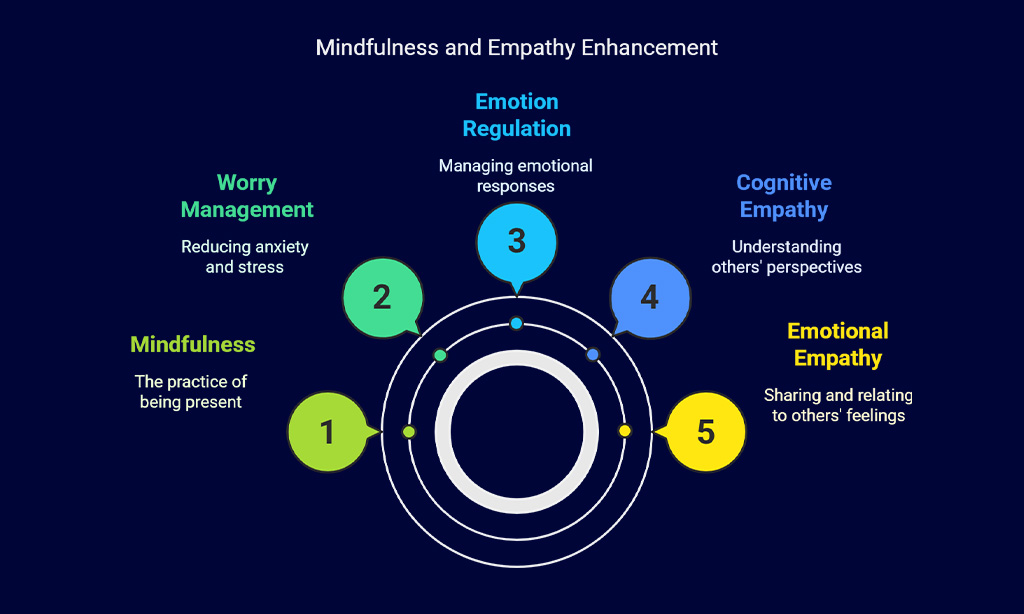Are you struggling to stay focused at work? Do your thoughts often wander, making it hard to complete tasks? Many people find it hard to concentrate in today’s busy world.
Mindfulness Practices To Boost Focus At Work can really help. These practices help you pay attention to your body. You focus on each part to lower stress and think more clearly.
Keep reading to find simple ways to sharpen your focus and feel calmer!
The Importance of Mindfulness at Work
Mindfulness at work matters a lot. It can boost mental health and workplace productivity. Stress management becomes easier with mindfulness exercises. Employees can be happier and more engaged.
Mindfulness can reduce absenteeism, improving job satisfaction. Regular practice helps people focus. It also cuts down stress. These practices involve focusing on each body part. This deliberate attention reduces stress.
It improves concentration. Mindfulness also helps create a calm, focused space. This leads to better productivity among employees. They become more alert, too.
Mindful work environments benefit everyone. Techniques like deep breathing help. Meditation and mindful strolls also work. When attention drifts, these methods bring it back. People can then refocus on tasks.
Morning meditation is helpful. Conscious breathing also works to reduce stress. A mindful work area is key. Research shows that mindfulness helps employees. Their focus gets better and their worry decreases.
This can really boost their mental health.
10 Mindfulness Practices to Boost Focus
Want to boost your focus? There are ten easy ways to do it using Tools like mindfulness meditation.
5-Minute Breathing Exercise
Mindful breathing is a great way to reduce stress. Try a quick, five-minute breathing exercise. It can really help your mental health! Focus on your breath going in and out. This brings you to the present moment.
First, find a quiet spot. Then, close your eyes and breathe in slowly. Hold it for a second, and breathe out slowly. Counting breaths can also improve focus. Do this for five minutes.
This simple method relaxes your body and mind. It improves focus and reduces anxiety, so your workplace productivity will be better!
The Body Scan
Body scan is a great relaxation technique. It reduces mental health and boosts workplace mindfulness. This activity involves focusing attention. You should pay attention to each body part.
Focus in a deliberate manner. It helps alleviate stress. It also improves focus and concentration.
During a body scan, you can ease stress. You can also improve your emotional health. Breathing methods can help relax your body. Guided imagery could also help. Relaxation techniques, such as meditation, can work too.
Mindfulness exercises can help you relax your mind.
Mindful Listening
Mindful listening means you pay full attention. You focus on what someone says. You avoid planning what you will say next. Good listening can boost workplace satisfaction. It also builds stronger relationships.
This supports employee engagement.
Try active listening to empathize with people. Focus on their words and feelings. Show them you care by empathizing. Really hear what they say—their concerns and gut feelings. It can reduce workplace stress.
This helps with stress management, too.
Declutter Your Workspace
A clean space helps with focus. Remove anything that you don’t need. This helps to reduce distractions and improve workplace mindfulness. A tidy desk can boost workplace productivity.
A mindful workspace supports mental well-being. It allows you to concentrate. Such a space also invites positive emotions. Organize your work area. This helps you stay calm and focused, leading to improved job satisfaction.
Walking Contemplation
Go for a mindful walk. Walking contemplation is simple. Focus on how your body moves. Pay attention to each step. Notice the feeling in your feet. Feel the ground under you. Focus can reduce work stress.
During walking meditation, let thoughts come and go. Do not hold onto them. Simply observe them without judging. Bring your attention back to walking. Focus on your breath. This practice can boost workplace mindfulness.
Regular mindful movement, even walking, boosts your emotional regulation and mental health.
Mindful Gratitude
Expressing mindful gratitude boosts workplace satisfaction. Employee engagement grows through thankfulness. Job satisfaction increases with gratitude practices. One should take time to appreciate good things.
Notice small wins and positive interactions. Acknowledge efforts by coworkers and your contribution. Studies show gratitude improves mental health. It also reduces stress and anxiety.
Start a gratitude journal. Write down things you appreciate each day. Share your gratitude with others. It will improve your state of mind. This simple exercise shifts focus. It promotes positive psychology at work and affects your emotional regulation.
Mindful gratitude creates a more supportive, happier workplace.
Take a Digital Break
Constant connection can increase work stress. Short breaks from screens can boost focus. Digital breaks aid mental health. Set timers for breaks. Use that time for mindful breathing.
Step away from your computer. Avoid email and social media. Go for a short walk. Studies show mindfulness training reduces anxiety. Mindfulness exercises help with focus. Research shows mindfulness practice in organizations helps employees.
This improves focus and lessens anxiety. These breaks can help create a calm workspace. Calmness improves productivity.
The Tangerine Experience
Try the tangerine experience. It uses all your senses. First, hold a tangerine. Notice its color and texture. Feel its weight. Next, peel the tangerine slowly. Listen to the sound.
Inhale its citrus aroma. Now, look at the segments. Finally, eat one piece mindfully. Savor the flavor and texture. This exercise boosts focus. Mindful eating improves concentration.
It helps reduce work stress.
Eating mindfully brings awareness to your daily routine. It is a simple tool for workplace mindfulness. This can positively impact well-being. It also improves job performance and employee satisfaction.
Focus on aromas and pleasures to improve mental health and reduce stress. This practice creates a calm work environment. It improves alertness among employees.
Silent Meeting
Meetings can be more focused. A silent meeting is a great way to practice workplace mindfulness. People focus on the issue at hand. It may improve employee engagement. Research shows mindfulness practice in organizations can boost focus.
Also, it can cut anxiety.
During these meetings, everyone is quiet. People write down their thoughts. This helps with stress management. Then, people share their ideas. This can lead to better workplace satisfaction.
Silent meetings help people live in the present moment. These meetings help to create a calm setting.
Mindful Eating
Mindful eating is a great mindfulness exercises. This practice helps you focus on your food. Pay attention to each bite. Notice the tastes, smells, and textures. Mindful eating can lower work stress.
It also boosts workplace mindfulness.
You can try mindful eating daily. It’s easy to add to your routine. Eating this way improves focus. It also enhances concentration. Research finds mindfulness can help at work. It helps employees improve focus.
It can also reduce anxiety. Mindful eating creates a calmer work setting, too.
Benefits of Practicing Mindfulness at Work
Doing mindfulness at work can help in many ways. You might see better focus after trying it.
Enhanced Focus and Concentration
Mindfulness at work can help you focus. These brain training exercises help you pay attention to each part of your body. It can improve your concentration, too. In fact, brain training exercises relax both your body and mind.
A calm and focused space at work leads to better alertness. It also boosts employee productivity.
Deep breathing is a good technique. Also, meditation can help you refocus on tasks. For example, mindful walking is a great activity. When your attention drifts, bring it back. Counting also helps, as does mindful eating.
Daily practice improves your focus. Evidence proves that mindfulness practice can improve focus. Importantly, these workplace mindfulness activities reduce anxiety.
Reduced Stress and Anxiety
Workplace mindfulness can cut stress. It also helps with anxiety. Research shows mindfulness aids focus and lowers anxiety. Use mindfulness practice to improve your mental health. Stress reduction is a key benefit.
Mindfulness exercises help people feel calmer. These exercises involve focusing on each part of the body. This deliberate focus can ease tension and boost your concentration.
Mindful breathing and meditation really help. They bring attention back when it drifts. Then you can refocus on tasks. A calm mind boosts workplace satisfaction. Deep breathing and mindful walking are great stress relievers.
So is mindful eating. Try morning meditation to start your day right. Create a mindful workspace. This will reduce work stress and help prevent burnout.
Takeaways
Focus and calm can improve with mindfulness. These practices are easy to use and very helpful. Try these tips for less stress and more focus. You can find more help from stress programs at your job.
A peaceful mind helps you do better work. Start some mindful practices soon!
FAQs on Mindfulness Practices To Boost Focus At Work
1. What are mindfulness exercises, and can they really help at work?
Yep, mindfulness exercises—like mindful breathing or a quick body scan—can really boost focus and help with stress management at work… they’re great for mental health!
2. How does workplace mindfulness affect workplace productivity and job satisfaction?
Workplace mindfulness, through practices like mindful listening, can improve employee engagement, workplace satisfaction, and even help with emotional regulation—leading to better workplace productivity and happier employees.
3. Can mindfulness training help with work stress and burnout prevention?
Absolutely! Mindfulness training and even guided meditations can be super effective for stress reduction, burnout prevention, and improving overall mental wellbeing… it’s all about learning to live in the moment.
4. What’s the deal with mindfulness-based stress reduction (MBSR), and how’s it different?
Mindfulness-based stress reduction (MBSR) is a special program that uses mindfulness to tackle stressors and reduce work stress… it’s a structured approach to help you feel less stressed.
5. How can I use mindfulness to deal with worries and improve my emotional empathy at work?
By practicing mindfulness, you can learn to manage worries, improve emotion regulation, and boost both cognitive empathy and emotional empathy… it’s about being present and understanding others.
6. Besides meditating, what other simple mindfulness practices can I try to improve my mental health and physical health?
Besides meditating, try mindful eating, stretching exercises, or just focusing on your breath… these simple things can improve your mental health, physical health, and even help with conditions like high blood pressure or asthma!







































